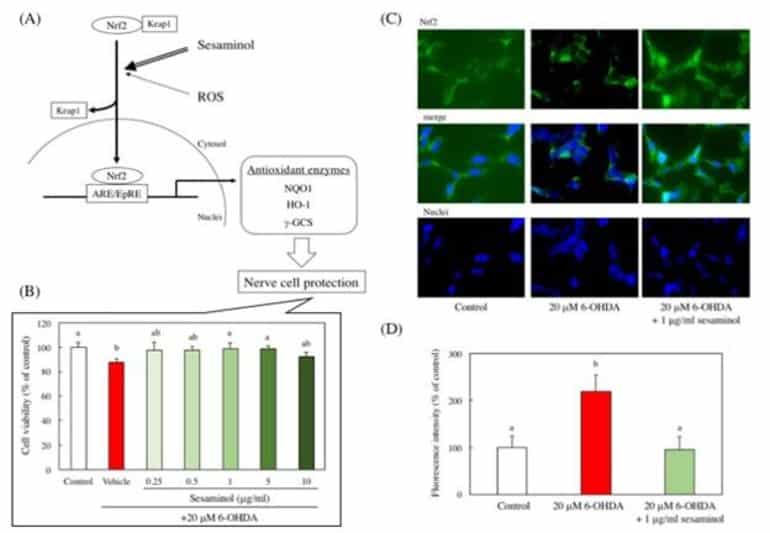Summary: Sesaminol, a chemical byproduct of sesame seed shells, has neuroprotective properties against Parkinson’s disease.
Source: Osaka City University
Sesame seed oil, used by many for its nutty aroma and high burn-point, is made by extracting the fatty oils from sesame seeds, with the empty shells thrown out as waste. In a literal instantiation of the age-old adage “one man’s trash is another man’s treasure”, researchers discovered that a chemical called sesaminol, abundant in this waste, has protective effects against Parkinson’s disease.
“Currently there is no preventive medicine for Parkinson’s disease”, states OCU Associate Professor Akiko Kojima-Yuasa, “we only have coping treatments”. Associate Professor Kojima-Yuasa led her research group through a series of experiments to understand the effects of sesaminol on in vitro and in vivo Parkinson’s disease models.
Parkinson’s disease is caused when certain neurons in the brain involved with movement break down or die due in part to a situation called oxidative stress – neurons in the brain come under extreme pressure from an imbalance between antioxidants and reactive oxygen species (ROS). The team found in cell-based in vitro experiments that sesaminol protected against neuronal damage by promoting the translocation of Nrf2, a protein involved in the response to oxidative stress, and by reducing the production of intracellular ROS.
In vivo experiments brought Associate Professor Kojima-Yuasa’s team equally promising results. The impairment of movement due to Parkinson’s disease is the result of damaged neurons producing less dopamine than is naturally needed. The team showed that mice with Parkinson’s disease models show this lack of dopamine production.

However, after feeding the mice a diet containing sesaminol for 36 days, the research team saw an increase in dopamine levels. Alongside this, a rotarod performance test revealed a significant increase in motor performance and intestinal motor function.
With the first-ever medicine for Parkinson’s disease potentially being the naturally occurring food ingredient sesaminol, and this ingredient being found in the naturally occurring waste of the sesame seed industry, Associate Professor Kojima-Yuasa and her team are ready to take their work to the clinical trial phase and connect the consumption/production chain in a way that, as she puts it, “prevents diseases with natural foods to greatly promote societal health.”
About this Parkinson’s disease research news
Source: Osaka City University
Contact: James Gracey – Osaka City University
Image: The image is credited to Akiko Kojima-Yuasa
Original Research: Open access.
“Sesaminol prevents Parkinson’s disease by activating the Nrf2-ARE signaling pathway” by Akiko Kojima-Yuasa et al. Heliyon
Abstract
Sesaminol prevents Parkinson’s disease by activating the Nrf2-ARE signaling pathway
Parkinson’s disease (PD) is a neurodegenerative disease caused by the degeneration of substantia nigra neurons due to oxidative stress. Sesaminol has strong antioxidant and anti-cancer effects. We investigated the preventive effect on PD as a new physiological action of sesaminol produced from sesaminol glycoside using in vitro and in vivo PD models.
To prepare an in vitro PD model, 6-hydroxydopamine (6-OHDA) was added to human neuroblastoma (SH-SY5Y cells). The viability of SH-SY5Y cells decreased dose-dependently following 6-OHDA treatment, but the addition of sesaminol restored viability to the control level. 6-OHDA increased intracellular reactive oxygen species production, and the addition of sesaminol significantly suppressed this increase. No Nrf2 expression in the nucleus was observed in the control group, but a slight increase was observed in the 6-OHDA group. The sesaminol group showed strong expression of Nrf2 in the cytoplasm and nucleus. NAD(P)H: quinone oxidoreductase (NQO1) activity was enhanced in the 6-OHDA group and further enhanced in the sesaminol group.
Furthermore, the neurotoxine rotenone was orally administrated to mice to prepare an in vivo PD model. The motor function of rotenone-treated mice was shorter than that of the control group, but a small amount of sesaminol restored it to the control level. The intestinal motility in the rotenone group was significantly lower than that in the control group, but it remained at the control level in the sesaminol group. The expression of α-synuclein in the substantia nigra increased in the rotenone group but decreased in the sesaminol group.
The rotenone group exhibited shortening and damage to the colonic mucosa, but these abnormalities of the colonic mucosa were scarcely observed in the sesaminol group. These results suggest that sesaminol has a preventative effect on PD.







